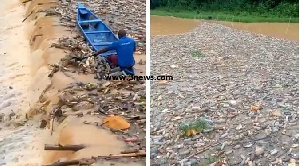The treatment plant is the main source of water supply to the north-western part of the Kumasi metropolis. Areas like Kwadaso, Asuoyeboah, Abuakwa, Nkwawie, Akropong, Koforidua and surrounding communities source water from the Owabi Dam.
Any mechanical fault at the Barekese Water Treatment Plant means water shortage for the people of Kumasi and its environs; the Owabi though operational, only augments water supply to the people.
But the life of the dam is under serious threat.
Massive encroachment has removed parts of the forest cover, exposing the dam to environmental hazards.
Dr Shalom Addo-Danso, a researcher at the Forestry Research Institute of Ghana, says water bodies need trees and vegetation to survive.
“Most of our water bodies get their source from the forest and part of the reasons why some forest reservations were made was to protect these water sources.”
Dr. Addo-Danso says felling trees along water bodies is tantamount to removing the protective cover of the water body.
It exposes it to evaporation and sedimentation.
“If there is excessive logging or there is continuous removal of the trees, it may have a negative impact on the water body. As soon as you remove trees, it creates space and if there is rainfall there is no interception…it will get directly into the ground and this will cause sedimentation.”
Estate developers have destroyed a number of the Owabi Dam’s protective cover.
Charles Tulashie, acting Regional Chief Manager in charge of Ashanti Production at the Ghana Water Company Limited, revealed that in 1998, a Kumasi high Court ruled against developing structures on the boundaries of the Owabi Dam, but the ruling has flatly been flouted and to Mr Tulashie chiefs from the surrounding communities are complicit.
“The court ruled in our favour, our catchment areas were clearly defined but, they are still building. There is a chief there who is spearheading…there was a day we went there with one former sector minister then he (chief) was there selling the land,” he lamented.
According to the acting Chief Production Manager, if the massive encroachment continues the dam will be shut down.
“We have said that in our own estimation that in the next five years, many parts of the [Ashanti] Region will be hit with water crisis, because now the volume of water in the dam has dropped from 22.5 feet deep to 6 feet deep.”
Perhaps, the most disturbing part of the problem is the indiscriminate dumping of plastic waste into the Owabi Dam.
Tonnes of plastic waste are lodged in the water body. These waste find their way into the dam because the vegetation has been depleted, making the Owabi Dam vulnerable.
Alhaji Adam Yakubu, who is the Ashanti Regional Water Quality Manager, says quantity of water is affected with cost of treatment soaring in recent years because of the level of pollution.
“It (pollution) affects the quantity of water that finally we send to the consumers. We should have at least 95% recoverable but we do about 70% now the rest is discarded.”
Several parts of Kumasi have not had stable water supply since December 2020.
Ruth Appiah, a resident of Kwadaso and an unemployed mother of two, needs not less than GH¢50, which is equivalent to about $12, to access potable water.
She, sometimes, solicits from family members. If she is unsuccessful she resorts to an unwholesome stream to fetch water for her house chores.
“It has not been easy. As a mother who is unemployed, I go through a lot in getting clean water for consumption.”
Sustainable Development Goal VI targets clean water and sanitation by the end of 2030. It is also estimated that each day nearly one thousand children die due to preventable water and sanitation-related diarrhoea diseases, according to the United Nations global goals.
Ruth and her two children may be exposing themselves to water related diseases because of their social status.
Many like Ruth undergo the same struggle over long distances, sometimes compelled to go for unwholesome sources.
The UN has projected that by 2050 at least one in four people will suffer recurring water shortages. The situation at Owabi Dam draws the predicted catastrophe even closer before the time.
“Eventually, there will be a shutdown because at the treatment site we have upper, middle and down extraction. The down and the middle are silted so we are now using the upper so if the upper too is silted that means there will be no flow of raw water for processing so eventually, the plant has to be shutdown,” says Alfred Galenku, Owabi Dam Station Manager.
“We forget that the water cycle and the life cycle are one,” once said by Jacques Yves Cousteau.
Source: 3 News
 Home Of Ghana News Ghana News, Entertainment And More
Home Of Ghana News Ghana News, Entertainment And More




